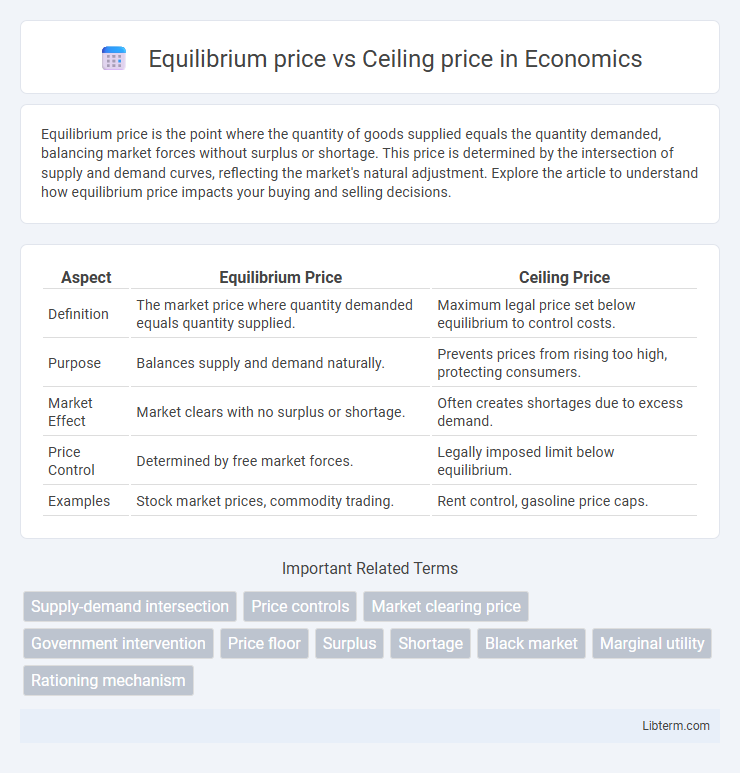Equilibrium price is the point where the quantity of goods supplied equals the quantity demanded, balancing market forces without surplus or shortage. This price is determined by the intersection of supply and demand curves, reflecting the market's natural adjustment. Explore the article to understand how equilibrium price impacts your buying and selling decisions.
Table of Comparison
| Aspect | Equilibrium Price | Ceiling Price |
|---|---|---|
| Definition | The market price where quantity demanded equals quantity supplied. | Maximum legal price set below equilibrium to control costs. |
| Purpose | Balances supply and demand naturally. | Prevents prices from rising too high, protecting consumers. |
| Market Effect | Market clears with no surplus or shortage. | Often creates shortages due to excess demand. |
| Price Control | Determined by free market forces. | Legally imposed limit below equilibrium. |
| Examples | Stock market prices, commodity trading. | Rent control, gasoline price caps. |
Understanding Equilibrium Price
Equilibrium price is the market price at which the quantity of goods supplied equals the quantity demanded, resulting in a stable market condition without shortages or surpluses. This price is determined by the intersection of the supply and demand curves, reflecting the true market value based on consumer willingness and producer costs. In contrast, a ceiling price is a government-imposed maximum price set below the equilibrium price to make goods more affordable, often causing shortages as demand exceeds supply.
Defining Ceiling Price
Ceiling price, also known as price ceiling, is the maximum legal price that can be charged for a good or service, set by government regulation to prevent prices from rising above a certain level. It is established below the equilibrium price--the point where supply meets demand--leading to potential shortages as the quantity demanded exceeds quantity supplied. Unlike the equilibrium price, which naturally balances the market, a ceiling price artificially restricts price increases to protect consumers from high costs.
Key Differences Between Equilibrium and Ceiling Price
Equilibrium price is the market price where the quantity of goods supplied equals the quantity demanded, ensuring a stable market condition without shortages or surpluses. Ceiling price, set by government regulation, is a legal maximum price below the equilibrium price intended to make essential goods affordable, often leading to shortages due to increased demand and restricted supply. The key difference lies in equilibrium price being a naturally determined market balance point, while ceiling price is an imposed limit that disrupts market forces.
How Equilibrium Price Is Determined
Equilibrium price is determined where the quantity of goods demanded by consumers equals the quantity supplied by producers, balancing market forces of supply and demand. This price ensures no surplus or shortage exists, allowing the market to clear efficiently. In contrast, a ceiling price is a government-imposed limit set below the equilibrium price to control affordability, often causing shortages.
Government Intervention: The Role of Price Ceilings
Price ceilings are government-imposed limits on how high a price can be charged for a product, designed to protect consumers from exorbitant costs. Unlike the equilibrium price, which is determined by the natural interaction of supply and demand, price ceilings set a maximum price below the equilibrium, leading to potential shortages when demand exceeds supply. This form of government intervention aims to make essential goods more affordable but can result in reduced supply and inefficiencies in the market.
Economic Effects of Ceiling Prices
Ceiling prices set below the equilibrium price create shortages by increasing demand while reducing supply, leading to inefficiencies in the market. These price controls often result in black markets, reduced product quality, and decreased producer incentives, distorting natural market signals. Governments impose ceiling prices to protect consumers from high prices but must balance these interventions against potential economic inefficiencies.
Impact on Supply and Demand
Equilibrium price is determined by the intersection of supply and demand, ensuring that the quantity supplied equals the quantity demanded, which maintains market balance. Ceiling price, set below the equilibrium, creates a maximum allowable price that can lead to excess demand and supply shortages as producers are less incentivized to supply goods. This price control disrupts the natural market adjustments, often causing persistent shortages and inefficiencies in resource allocation.
Examples of Ceiling Price in the Real World
Ceiling price, often imposed by governments, is a maximum limit on the price of essential goods like rent or gasoline to prevent prices from becoming unaffordable, contrasting with the equilibrium price where supply meets demand naturally. Examples include rent control policies in cities like New York and San Francisco, which cap residential rents to protect tenants from steep increases. Another real-world instance is ceiling prices on fuel during crises in countries like India, aiming to keep fuel affordable despite supply shocks.
Advantages and Disadvantages of Price Ceilings
Price ceilings set maximum limits on prices to prevent market prices from rising above a specified level, benefiting consumers through increased affordability but often causing shortages as supply decreases. This intervention can lead to reduced producer revenue and market inefficiencies due to the gap between ceiling prices and equilibrium prices, where supply and demand naturally balance. While price ceilings protect buyers from inflation or monopolistic pricing, they risk decreasing product quality and discouraging investment in production.
Equilibrium vs Ceiling Price: Summary and Conclusions
Equilibrium price is the market-clearing price where supply equals demand, ensuring efficient allocation of resources without surplus or shortage. Ceiling price, set below the equilibrium, aims to make goods more affordable but often leads to shortages and reduced market efficiency due to suppressed prices. Comparing both, equilibrium price balances market forces naturally, while ceiling price interventions distort supply-demand dynamics, causing unintended economic consequences.
Equilibrium price Infographic

 libterm.com
libterm.com